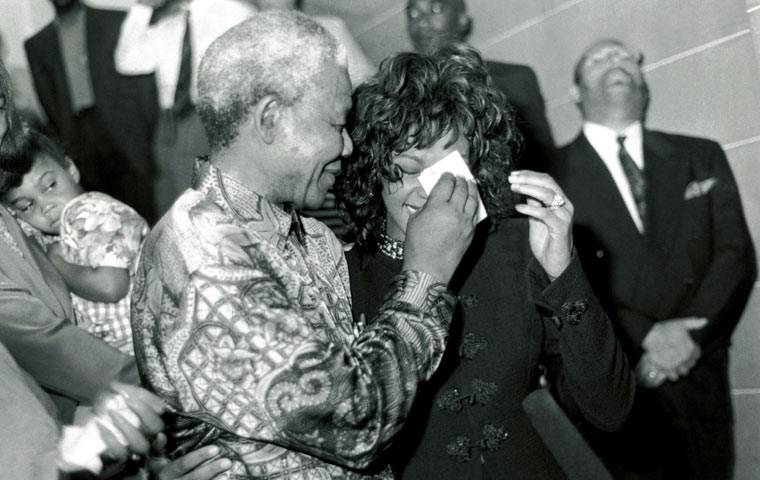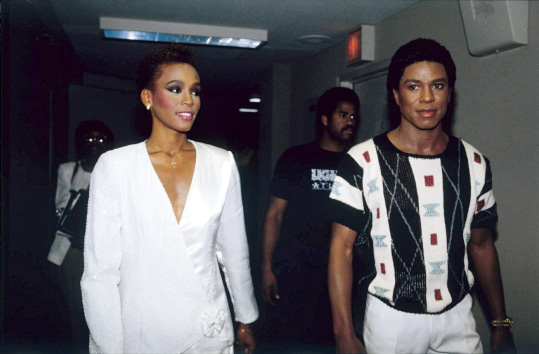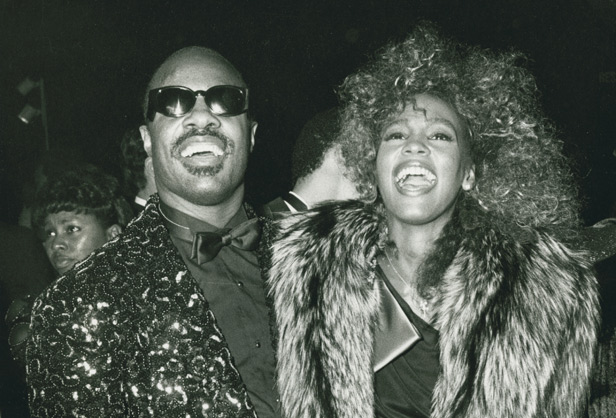Nelson Mandela wiping the tears of a very emotional Whitney Houston on the steps of the Union Buildings in Pretoria in 1994.
Wednesday 22 February 2012
Monday 20 February 2012
Whitney & Jermaine
Whitney and Jermaine Jackson during a singing rehearsal for the CBS television soap opera As the World Turns in New York, July 25, 1984.
Sunday 19 February 2012
Monday 13 February 2012
Gone Too Soon
For Jimi Hendrix, Bob Marley, Rick James, Teena Marie, Randy Ran, Nick Ashford, Luther Vandross, Lisa 'Left Eye' Lopes, Marvin Gaye, Tammi Terrell, Teddy Pendergrass, Curtis Mayfield, Etta James, James Brown, Michael Jackson, Heavy D, Jam Master Jay, Aaliyah, MC Guru, Biggie Smalls, Tupac Shakur, Amy Winehouse and now Whitney Houston.
Gone too soon.
Gone too soon.
Sunday 5 February 2012
Some Groundbreaking Jazz To Keep The Winter Blues Away...
...three tracks from sessions that broke new ground in Jazz, from three talents that weren't afraid to push that envelope. Enjoy.
- FVS
- FVS
Dave Brubeck - Blue Rondo A La Turk (1959)
From the album Time Out by The Dave Brubeck Quartet, Recorded at Columbia's 30th Street Studio in New York City and released in 1959 on Columbia Records.
Blue Rondo à la Turk is a jazz standard composition by Dave Brubeck. It appeared on the 1959 album Time Out. It is written in a 9/8 and swing 4/4 time signatures (the rhythm determine the pulse of the music you are playing or listening to) at a time when most jazz was composed entirely in 4/4.
Brubeck heard the unusual 1-2/1-2/1-2/1-2-3 rhythm performed by Turkish musicians on the street. Upon asking the musicians where they got the rhythm, one replied "This rhythm is to us, what the blues is to you." Hence the title Blue Rondo à la Turk.
The piece is sometimes incorrectly assumed to be based on the Mozart composition Rondo alla Turca. In a 2003 interview, Brubeck commented that "I should've just called it 'Blue Rondo', because the title just seemed to confuse people.'
Boasting the first jazz instrumental to sell a million copies, the Paul Desmond-penned Take Five, Time Out captures the celebrated jazz quartet at the height of both its popularity and its powers. Recorded in 1959, the album combines superb performances by pianist Brubeck, alto saxophonist Desmond, drummer Joe Morrello and bassist Gene Wright. Along with Take Five, the album of course features 'Rondo', another one of the group's signature compositions. Though influenced by the West Coast-cool school, Brubeck's greatest interest and contribution to jazz was the use of irregular meters in composition, which he did with great flair. Much of the band's appeal is due to Desmond, whose airy tone and fluid attack often carried the band's already strong performances to another level. Together, he and Brubeck proved one of the most potent pairings of the era.
French singer Claude Nougaro has used this standard as a musical foundation for his song "A bout de souffle".
The Lively Ones television show first broadcast July 25, 1962. The Quartet is shown riding a magic carpet over a freeway in Los Angeles. As you do.
John Coltrane - My Favorite Things (1960)
My Favorite Things is the seventh album by jazz musician John Coltrane, recorded October 21,1960 and released in 1961 on Atlantic Records. It was the first album to feature Coltrane's playing on soprano saxophone, and yielded a commercial breakthrough in the form of a hit single that gained popularity in 1961 on radio, an edited version of the title song. In 1998, the album was a recipient of the Grammy Hall of Fame award.
After leaving the Davis band, for his first regular bookings starting at New York's Jazz Gallery club in the summer of 1960 Coltrane assembled the first version of John Coltrane Quartet; they had signed for Atlantic records the previous year. The line-up settled to McCoy Tyner on piano, Steve Davis on bass, and Elvin Jones on drums by the autumn of that year. Sessions the week before Halloween at Atlantic Studios yielded the track Village Blues for Coltrane Jazz and the entirety of My Favourite Things, along with the tracks that Atlantic would later assemble into Coltrane Plays the Blues and Coltrane's Sound.
When he recorded Giant Steps, his first record with his new group was also his debut playing the soprano saxophone;. the hugely successful My Favorite Things. Around the end of his tenure with Miles Davis, Coltrane had begun playing soprano saxophone, an unconventional move considering the instrument's near obsolescence in jazz at the time. His interest in the straight saxophone most likely arose from his admiration for Sidney Bechet and the work of his contemporary, Steve Lacy, even though Miles Davis claimed to have given Coltrane his first soprano sax.
The new soprano sound was coupled with further exploration. For example, on the Gershwin tune But Not For Me, Coltrane employs the kinds of restless harmonic movement used on Giant Steps (movement in major thirds rather than conventional perfect fourths) over the A sections instead of a conventional turnaround progression. Several other tracks recorded in the session utilized this harmonic device, including 26–2, Satellite, Body and Soul, and The Night Has a Thousand Eyes.
Released a mere month after Coltrane Jazz, My Favourite Things was unlike his first two albums for Atlantic; this one contains no original compositions, instead jazz versions of four pop standards. The album was also the first to quite clearly mark Coltrane's change from bebop to modal jazz, which was slowly becoming apparent in some of his previous releases.The famous track is a modal rendition of the Rodgers and Hammerstein song My Favorite Things from The Sound of Music. The melody is heard numerous times throughout, but instead of having a solo over the written chord changes, both Tyner and Coltrane taking extended solos over vamps of the two tonic chords, E minor and E major, played in waltz time.
In the documentary The World According to John Coltrane, narrator Ed Wheeler remarks on the difference the popularity this song had on Coltrane's career:
"In 1960, Coltrane left Miles (Davis) and formed his own quartet to further explore modal playing, freer directions, and a growing Indian influence. They transformed My Favorite Things, the cheerful populist song from The Sound of Music, into a hypnotic eastern dervish dance. The recording was a hit and became Coltrane's most requested tune - and a bridge to broad public acceptance."
On March 3, 1998, Rhino Records reissued Coltrane Jazz as part of its Atlantic 50th Anniversary Jazz Gallery series. Included as bonus tracks were both sides of the My Favorite Things single, originally released in 1961.
Recorded July 7, 1963 at the Newport Jazz Festival; track 1 is a 17;31 version of My Favorite Things.
Joe Henderson - Mode For Joe (1960)
The second track on side Henderson's original Mode For Joe album. Recorded at the Van Gelder Studio, Englewood Cliffs, New Jersey on January 27, 1966 and released on Blue Note records.
Given the date of this release and the band lineup, one might assume that this is a straight-up hard-bop album. However this composition, featuring trumpeter Lee Morgan, trombonist Curtis Fuller, vibraphonist Bobby Hutcherson, pianist Cedar Walton, bassist Ron Carter, and drummer Joe Chambers is a great example of modern jazz at its best. The album was recorded during a time of sweeping musical changes due to developments in free jazz, soul jazz, and even early experiments with fusion. It was a time when the bluesy and funky leanings of hard-boppers were giving way to more individualized contemporary approaches. One of the best examples of this shift, Mode For Joe sounds more like the experimental work of Branford Marsalis than the groovy musings of Art Blakey and the Jazz Messengers.
Cedar Walton is no minor composer, but he may have reached the pinnacle with Mode for Joe. Chords gracefully ascend and descend, and optimal use is made of spacing and timing. The expanded horn ensemble along with Hutcherson's vibes gives the song the elegant heft it demands, without being too large to play nimbly.
But this song isn't perfect just because Walton scored it flawlessly, though. Mode For Joe is a signature Joe Henderson performance as well. In the midst of the call and response between Henderson and the rest of the front line, the leader shocks the listener by inserting some rough, dissonant lines that he repeats precisely as played the first time. His solo that follows is likewise a mixture of cool, precise phrasing with loosely conceived statements punctuated by coarse honks. Like the great painter Picasso, Joe Henderson combines the odd with the beautiful to create something oddly beautiful.
The last track on Mode For Joe, Free Wheelin’, is the only dyed-in-the-wool hard-bop tune heard here. Other than that, this outing’s mostly up-tempo songs serve as vehicles for solos. Henderson himself proves that the template for players such as Marsalis, Joe Lovano, and Joshua Redman was invented a generation earlier, as evidenced on A Shade of Jade, Black, and others, making this one of the sax legend’s most intriguing albums.
Subscribe to:
Posts (Atom)







